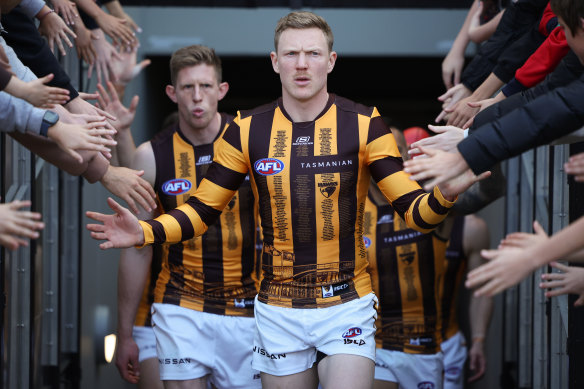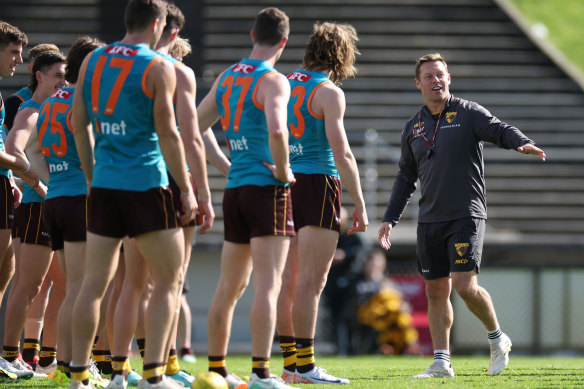By Marc McGowan
A figurative line was drawn above James Sicily’s name.
It was the summer after Hawthorn’s tumultuous 2021 season, during which the Hawks severed ties with four-time premiership coach Alastair Clarkson and replaced him with his former captain Sam Mitchell, who was on Collingwood’s radar to be Nathan Buckley’s successor.

Man on a mission: James Sicily.Credit: Getty Images
They acted quickly and, perhaps, a bit messily to ensure Mitchell’s first senior coaching job would be in brown and gold, even if it meant ending Clarkson’s legendary tenure a year early and handing him a $900,000 payout.
Mitchell, football boss Rob McCartney, football director Richie Vandenberg and list manager Mark McKenzie were in the so-called “war room” at Waverley Park thrashing out a new list strategy.
Hawthorn had just finished barely above the bottom four despite having one of the league’s oldest lists, so something had to give. Fast-forward to today, and Mitchell’s Hawks are one win away from booking a shock finals berth with a young list after having a 0-5 win-loss record in mid-April.
The plan from the start was to be more collaborative than the previous regime, which was ragingly successful until a sour end in more recent years – but duopolised by Clarkson and ex-football chief Graham Wright.

Sam Mitchell leads with a laugh at training this week.Credit: Getty Images
Melbourne and the Western Bulldogs played in the 2021 grand final, and the aforementioned quartet ran an exercise to decide between them, in a hypothetical scenario, how many Hawks would have played in that game – while also being young enough to feature in the club’s next premiership.
The number was only six, including Sicily, who turned 27 in January 2022.
It was not that anyone older than Sicily was written off, but Mitchell and co believed they needed to be realistic about how long it would take to compete for another premiership.
Jai Newcombe arrived via the mid-season draft the previous season and has since become a key midfield cog, but there was not enough certainty about him at that stage.
None of Tom Mitchell, Jaeger O’Meara or Chad Wingard – key planks in Clarkson’s vision to defy AFL gravity, to the point he gave away a series of first-round picks to get them – was part of the six either.
Nor was Irishman Conor Nash, who has now forced himself into that territory.
Mitchell and O’Meara famously departed in trades to Collingwood and Fremantle, respectively, by year’s end, with Hawthorn paying some of their wage to move them on, while they delisted Wingard last year before selecting him again in the pre-season draft (after his agent Tom Petroro’s intervention).
Mitchell, in particular, was viewed internally as blocking ascending star Will Day’s path to major midfield minutes.
Day, then only 20, was likely among the super six. The rest of that exclusive group might have been Blake Hardwick, Jarman Impey, Dylan Moore – fresh from a breakout season – and Mitch Lewis. Changkuoth Jiath and James Worpel were probably around the mark, too.
McKenzie was charged with analysing the rise and trends of recent premiers, including the Demons, although Mitchell made clear that he did not want to simply copy successful rivals and become an inferior version.
There were shades of Melbourne’s draft and trade strategy two years ago when the Hawks sent pick 27 and future second- and third-round selections to Sydney on draft night in return for No.18, which they used to select a kid from the Oakleigh Chargers called Josh Weddle.
That future second-rounder came via Fremantle, along with Lloyd Meek – now Hawthorn’s No.1 ruckman – in the O’Meara deal.
Coach Mitchell had a clear picture about how he wanted to play and the types of players he needed, including character traits and specific names for positions, such as “clever forwards”. Wingard and Luke Breust previously fit that bill, whereas Jack Ginnivan and Nick Watson are Generation Next.
Mitchell’s priority was to invest in the draft then quickly get as many AFL matches as possible into the emerging crop, from Newcombe to the likes of Day, Josh Ward, Cam Mackenzie, Weddle and Connor Macdonald.
There was an unwritten rule in Mitchell’s first two seasons that they would have double-digit players aged 23 or younger in their senior side each week, while they also persisted longer with younger players through struggles or form slumps than what many clubs do.
This strategy was underpinned by Mitchell’s motto for the Hawks’ brains trust to adopt the “longest view in the room”, according to a well-placed source who spoke on the condition of anonymity.
This was why Mitchell might have been frustrated but never panicked as Hawthorn copped consecutive shellackings to start last year then lost their first five matches in 2024.
“I think consistency of decision-making has been important,” Mitchell said this week.
“[We have been] big on strategy, so making sure strategically we were all heading, as a whole organisation, in the same direction. So whether that was the way the list was being built, the way we staffed the list, the way we developed the list, [or] the way we picked the selection for each game.
“I think the consistency of all those things going through the same filter [was important].
“Every single decision has gone through the strategic, ‘Is this the right decision, not just for this weekend, but for our strategy?’ ... I think that’s what’s led to the accelerated performance.”
Another person who had fingerprints on the Hawks’ list direction was Josh Vanderloo, formerly of the AFL and hired by Hawthorn as general manager of operations and special projects.
Vanderloo’s main job was to deliver the club an AFLW team, but he also chipped in on the AFL team’s list strategy based off his experience in developing the league’s player-movement mechanisms.
His knowledge came to the fore in last year’s trade period, when the Hawks capitalised on an obscure rule whereby Massimo D’Ambrosio could become a delisted free agent after Essendon offered him a one-year deal to remain on the rookie list for a third season.
The clubs ended up brokering a trade, but the Bombers were blindsided. D’Ambrosio has been excellent this season and might even make the extended All-Australian squad.
Analytics have been integral to Hawthorn’s recruiting decisions, too, with Steve Gloury – a data scientist who became the first person to score a full-time analytics job in the AFL with Fremantle eight years ago – employed to help in that area.
They also appointed North Melbourne’s former head recruiter Mark Finnigan in mid-2022 after identifying the need to bolster their recruiting department, then added Jarryd Roughead before this season as the Hawks’ free agency and trade player acquisition manager.
Roughead represents the next phase of Hawthorn’s list build.

On a roll: Sam Mitchell and his Hawks are one happy family.Credit: Getty Images
Just as the selection policy no longer has a heightened focus on a certain number of young players in the senior side, the Hawks are also increasingly on the lookout for mature-age additions in the trade and free agency space.
Tall defenders Tom Barrass and Josh Battle are their chief trade and free agency targets for this year, but they remain in the hunt for Giant Harry Perryman and asked the question about Bailey Smith, who seems headed to Geelong.
The club’s moves in last year’s trade period have also paid dividends, with D’Ambrosio, Ginnivan and Mabior Chol performing critical roles, while Jack Gunston’s impact on his return has also been a pleasant surprise.
Another source familiar with the situation told this masthead that Mitchell had a frank discussion with Gunston before the trade went through on what his expectations would be. A selfless approach was a must.
Giving up Brandon Ryan to the Brisbane Lions as part of the deal to bring back Gunston, who initiated the move, might seem counterintuitive to everything else the Hawks have done, but that trade delivered the selection that was passed on to Gold Coast for Chol.
It was another savvy piece of business, and Gunston has kicked 27 goals in 15 games while serving as a mentor to players such as Calsher Dear, who has stunned even Mitchell with his output in his debut season.
Anyone who matters at Hawthorn is at pains to point out there will be more challenges ahead, and they do not believe the blueprint is complete.
But there is sure to be some envy from opposition clubs wondering how the Hawks – who have won premierships in every previous decade since the 1960s – have raced past them again.
“[We were] trying to build a list, playing group [and] culture that would sustain us through successful times, and that would create a game style that would bring success for when our time for finals footy came, so we’ve been building towards it,” Mitchell said.
“There was no speed limit on how quickly that would be.
“The role of all of us as the support for the players is to put us in an environment where we can go as quickly as possible. Now we’re getting close, but we’re far from a finished product.”
Keep up to date with the best AFL coverage in the country. Sign up for the Real Footy newsletter.